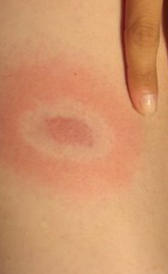General information about the symptoms of Lyme disease
This page attempts to provide a list of information of some of the possible symptoms of Lyme disease.
This information on symptoms was obtained from various sources and may
not be entirely accurate and not have to be a complete list of the
symptoms of Lyme disease.
Furthermore, symptoms of Lyme disease vary individually in each patient.
You should consult your doctor if you notice the first symptoms of Lyme
disease as only your doctor can provide a correct diagnosis of symptoms
accurately.
The symptoms of Lyme disease
In its early stages, Lyme disease can be a mild illness with symptoms similar to the flu , such as fever, chills, swollen lymph nodes, headaches, fatigue, muscle aches and joint pain. Symptoms appear between 7 and 10 days after the bite of an infected tick. Many people bitten by an infected tick develop a large rash, swelling the skin around the bite area. The rash may be warm to the touch, but usually is not painful. The eruptions vary in size, shape and color, but often have a clear appearance, a red circle with a clear center.
The nervous system abnormalities can include numbness, pain, weakness,
Bell's palsy (paralysis of the facial muscles), visual disorders and
symptoms of meningitis , such as fever, stiff neck and severe headache.
Other problems may not appear until weeks, months or years after a tick
bite are an increase in the difficulty to think and remember or nerve
damage in the arms and legs.
In most people, the first symptom of Lyme disease is a red rash known as erythema migrans. The rash starts as a small red spot at the site of the tick bite. This rash spreads over a period of days or weeks, forming a circular or oval rash. Sometimes the rash resembles a donut, which appears as a red ring surrounding a clear area with a red center.
The eruption, which can range from the size of a dime to the entire
width of the back of a person, appears after the first weeks of a tick
bite and typically occurs at the site of the bite. As the infection spreads, rashes on different parts of the body may occur.
The erythema migrans is often accompanied by symptoms such as fever, headache, neck stiffness, body aches and fatigue.
Although these flu-like symptoms may resemble common viral infections,
symptoms of Lyme disease tend to persist or may appear intermittently.
After several months of being infected by the bacterium Borrelia
burgdorferi, which causes the disease, more than half of the people who
are not treated with antibiotics develop recurrent attacks of pain in
inflamed joints and lasting from a few days to a few months. The arthritis can move from joint to joint, knee limb is more often affected. Between 10 and 20 percent of untreated patients go on to develop chronic arthritis.
Neurological symptoms
Lyme disease can affect the nervous system, causing symptoms such as
stiff neck and severe headache (meningitis), temporary paralysis of the
facial muscles (Bell's palsy), numbness, pain or weakness in the limbs
or loss of coordination motor.
More subtle changes such as memory loss, difficulty concentrating,
changes in mood or sleep habits have also been associated with Lyme
disease.
The nervous system abnormalities usually develop several weeks, months or even years after an untreated infection. These symptoms usually last for weeks or months and may recur.
General information about the symptoms of Lyme disease
This page attempts to provide a list of information of some of the possible symptoms of Lyme disease.
This information on symptoms was obtained from various sources and may
not be entirely accurate and not have to be a complete list of the
symptoms of Lyme disease.
Furthermore, symptoms of Lyme disease vary individually in each patient.
You should consult your doctor if you notice the first symptoms of Lyme
disease as only your doctor can provide a correct diagnosis of symptoms
accurately.
The symptoms of Lyme disease
In its early stages, Lyme disease can be a mild illness with symptoms similar to the flu , such as fever, chills, swollen lymph nodes, headaches, fatigue, muscle aches and joint pain. Symptoms appear between 7 and 10 days after the bite of an infected tick. Many people bitten by an infected tick develop a large rash, swelling the skin around the bite area. The rash may be warm to the touch, but usually is not painful. The eruptions vary in size, shape and color, but often have a clear appearance, a red circle with a clear center.
The nervous system abnormalities can include numbness, pain, weakness,
Bell's palsy (paralysis of the facial muscles), visual disorders and
symptoms of meningitis , such as fever, stiff neck and severe headache.
Other problems may not appear until weeks, months or years after a tick
bite are an increase in the difficulty to think and remember or nerve
damage in the arms and legs.
In most people, the first symptom of Lyme disease is a red rash known as erythema migrans. The rash starts as a small red spot at the site of the tick bite. This rash spreads over a period of days or weeks, forming a circular or oval rash. Sometimes the rash resembles a donut, which appears as a red ring surrounding a clear area with a red center.
The eruption, which can range from the size of a dime to the entire
width of the back of a person, appears after the first weeks of a tick
bite and typically occurs at the site of the bite. As the infection spreads, rashes on different parts of the body may occur.
The erythema migrans is often accompanied by symptoms such as fever, headache, neck stiffness, body aches and fatigue.
Although these flu-like symptoms may resemble common viral infections,
symptoms of Lyme disease tend to persist or may appear intermittently.
After several months of being infected by the bacterium Borrelia
burgdorferi, which causes the disease, more than half of the people who
are not treated with antibiotics develop recurrent attacks of pain in
inflamed joints and lasting from a few days to a few months. The arthritis can move from joint to joint, knee limb is more often affected. Between 10 and 20 percent of untreated patients go on to develop chronic arthritis.
Neurological symptoms
Lyme disease can affect the nervous system, causing symptoms such as
stiff neck and severe headache (meningitis), temporary paralysis of the
facial muscles (Bell's palsy), numbness, pain or weakness in the limbs
or loss of coordination motor.
More subtle changes such as memory loss, difficulty concentrating,
changes in mood or sleep habits have also been associated with Lyme
disease.
The nervous system abnormalities usually develop several weeks, months or even years after an untreated infection. These symptoms usually last for weeks or months and may recur.
Heart problems
Less than one in ten patients with Lyme disease develop heart problems
such as an irregular heartbeat, which may be accompanied by dizziness or
shortness of breath. These symptoms rarely last more than a few days or weeks. Such abnormalities of the heart, in general several weeks after infection arise.
Other symptoms of Lyme disease
Less frequently, Lyme disease can cause inflammation of the eyes, hepatitis and severe fatigue, although none of these problems usually occur without other symptoms of Lyme disease appear.
Early symptoms of infection:
- Rash known as erythema migrans
- Muscle and joint pain
- Headache
- Fever
- Fatigue
In early infection:
- Multiple injuries
- Facial paralysis or Bell's palsy
- Meningitis
- Radiculitis: numbness, tingling, burning ...
- Brief episodes of joint pain and inflammation
When the infection progresses:
- Arthritis, intermittent or chronic
- Encephalopathy, moderate or mild confusion
Less common symptoms of Lyme disease:
- Eye problems such as conjunctivitis
- Chronic skin disorders
- Encephalomyelitis: limb weakness and loss of motor coordination
General information about symptoms of gonorrhea
This page attempts to provide a list of information of some of the possible symptoms of gonorrhea.
This information on symptoms was obtained from various sources and may
not be entirely accurate and not have to be a complete list of symptoms
of gonorrhea.
Furthermore, symptoms of gonorrhea can vary in each patient individually.
You should consult your doctor if you notice the first symptoms of
gonorrhea as only your doctor can provide a correct diagnosis of
symptoms accurately.
Click on the link below if you want to see information on the treatment of gonorrhea .
Gonorrhea is one of the diseases most common sexually transmitted. This disease is caused by the bacterium Neisseria gonorrhoeae. The infection is transmitted from one person to another through sex. This disease, however, can be spread by simple kissing, sharing baths, towels, glasses or toilet seats.
Symptoms of gonorrhea
Soon after infection, most men have some type of symptom. The signs and symptoms of gonorrhea include a burning sensation when urinating and a yellowish white discharge from the penis. Sometimes men with gonorrhea may have pain or swelling in the testicles.
In women, the early symptoms of gonorrhea are often mild, and many women who are infected have no symptoms of infection. Even when a woman has symptoms, they can be so nonspecific that are confused with vaginal or bladder infection.
The symptoms and signs in women include a sensation of pain or burning
when urinating and a vaginal discharge that is yellow or sometimes
bloody.
Women with gonorrhea to have mild symptoms or no symptoms, are also at
risk of developing serious complications from the infection. Untreated gonorrhea in women can become pelvic inflammatory disease . Later, we will discuss the possible complications of gonorrhea.
Symptoms of rectal infection include diarrhea , anal itching, pain, bleeding and sometimes painful bowel movements. Infections in the throat cause few symptoms.
The first symptoms of gonorrhea often are mild. Symptoms usually appear between 2 and 10 days after sexual contact with an infected partner. Several people may be infected for several months without showing symptoms.
Signs and symptoms of Crohn's disease
The most common symptoms of Crohn's disease are diarrhea and abdominal pain, often in the lower right area.
Other symptoms that can cause this disease are rectal bleeding, weight loss and fever.
Bleeding may be serious and persistent, which can cause anemia . Children with Crohn's disease may suffer delayed development and stunted growth.
Crohn's disease is a chronic inflammatory bowel disease.
Primarily causes ulcerations (breaks in the mucosa) in the small
intestine and large, therefore, it can affect the digestive system from
the mouth to the anus.
Crohn's disease received its name in honor of the doctor who described
it in 1932. This disease is also known by other names, such as
granulomatous enteritis or colitis , regional enteritis, ileitis, or terminal ileitis.
Crohn's disease is closely related to another chronic inflammatory disease known as ulcerative colitis affects only the colon. Experts often refer to these two diseases together as inflammatory bowel disease. Both ulcerative colitis and Crohn's disease have no medical cure. Once the disease begins, they tend to fluctuate between periods of inactivity (remission) and activity (relapse).
Crohn's disease tends to be more common in relatives of patients with the same disease.
If a person has a relative with the disease, their risk of developing
the disease is estimated to be at least 10 times higher than the rest of
population. If the relative with Crohn's disease were a brother, the risk of developing the disease would be 30 times higher. Among the relatives of patients with ulcerative colitis is exactly the same.

